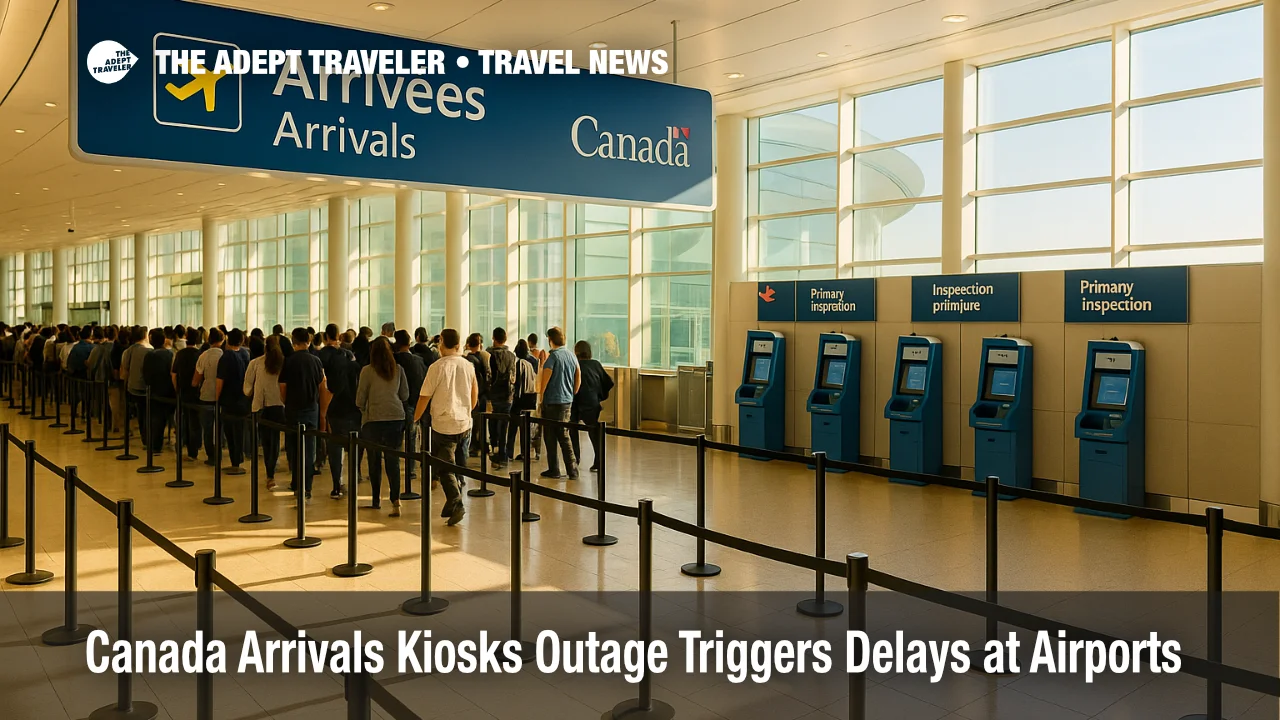Canada arrivals kiosks outage triggers delays at major airports

International arrivals across Canada faced hours-long lines after the Canada Border Services Agency's primary inspection kiosks went down late September 28, with residual delays noted early September 29 as systems were brought back online. Travelers reported aircraft holds and congestion at Toronto Pearson International Airport (YYZ), Montréal-Trudeau International Airport (YUL), Calgary International Airport (YYC), and Vancouver International Airport (YVR). U.S.-bound travelers connecting via Canada should add extra time or consider rerouting until processing throughput stabilizes.
Key points
- Why it matters: A nationwide kiosks failure slowed customs processing for international arrivals.
- Travel impact: Expect residual waits at major hubs even after restoration; tight U.S. connections are at risk.
- What's next: CBSA says service is restored, but short-term delays may continue as backlogs clear.
- U.S.-bound connectors: add 2-4 hours, or rebook via a U.S. hub to protect onward flights.
- NEXUS lanes generally flowed faster; standard lanes saw the longest lines.
Snapshot
CBSA confirmed an outage affecting primary inspection kiosks on September 28, followed by an early-morning September 29 update that service had been restored, with lingering delays possible while operations normalized. Airports and travelers reported ground holds on arrival, extended queues at customs, and terminal congestion at YYZ, YUL, YYC, and other gateways. Because Canada pre-clearance for many U.S. flights occurs before departure, missed connections cascaded into same-day rebooking pressure. If you are connecting to the United States through Canada in the next 24-48 hours, add a sizeable buffer, move to later flights, or reroute through a U.S. hub to clear customs on arrival instead. Monitor airline apps, and consider priority, NEXUS, or assistance lanes where eligible.
Background
Primary inspection kiosks are CBSA's self-service "e-gates" used to capture traveler declarations and biometrics before an officer completes inspection. When kiosks lose connectivity, flows revert to manual processing, sharply reducing hourly throughput. Sunday evening posts from airports and passengers described deplaning pauses while arrivals halls cleared, followed by long queues as officers processed travelers without kiosk support. Similar Canada-wide technical incidents earlier this year produced multi-hour waits before recovery. While today's failure was resolved, backlogs after system restarts can persist through the next day's peak banks, making early-week connectors most vulnerable.
Latest developments
CBSA restores kiosks, warns of short-term delays
CBSA stated early September 29 that the outage had been resolved and thanked travelers for their patience, cautioning that delays could continue briefly as normal processing resumes. Local coverage from Toronto and Montreal detailed hours-long waits Sunday evening, including reports of passengers held on aircraft until arrivals halls had capacity. Airports reminded travelers of longer-than-usual waits at customs as systems came back online. U.S. connectors with minimum transfer times below two hours were most exposed to misconnects; travelers with NEXUS generally cleared faster than standard lanes.
How to protect a U.S. connection via Canada
If you must connect via YYZ, YUL, YYC, or YVR on September 29-30, move to a later onward flight or request a same-day change to add 2-4 hours of buffer. Consider rebooking to connect through a U.S. hub instead of Canada to shift customs to your final arrival. Build in extra time for checked-bag reclaim and re-check where itineraries require it. Monitor broader operational headwinds too, such as weather-related reroutes or flow programs called in the U.S.; our recent roundups can help you anticipate additional friction points, including FAA daily air traffic report: September 27, 2025 and Hurricane Humberto: What travelers should know this week.
Analysis
This outage underscores how dependent border throughput has become on kiosk infrastructure. When e-gates fail, capacity effectively collapses to officer-only processing, causing immediate gridlock during peak arrival banks. Recovery is nonlinear; even after systems return, backlogs and crew-duty constraints ripple into the next morning. For U.S.-bound travelers, Canada's pre-clearance model can help in normal times, but during disruptions it shifts misconnect risk into the international arrivals hall. Practically, the best mitigation is time. Add hours of slack to any same-day U.S. connection via Canada for the next 24-48 hours, prioritize itineraries with protected minimum connection times, and use airline tools to move onto later departures without change fees where waivers apply. If your trip is flexible, reroute through a U.S. hub to complete customs on arrival. Keep an eye on concurrent factors, like Atlantic swell impacts on Bermuda and Bahamas operations, which can indirectly shuffle aircraft and crews and compound delay exposure. In short, protect your schedule with buffers or alternate routings while kiosks stabilize and arrivals flows even out.
Final thoughts
CBSA's quick restoration should ease the crunch, but knock-on effects will linger through at least September 30 at the largest gateways. If your itinerary requires a Canada-to-U.S. connection, proactively add buffer time, leverage NEXUS or priority options, or reroute through a U.S. hub. A little schedule insurance now can prevent a misconnect later while airports digest the Canada arrivals kiosks outage.
Sources
- Canada Border Services Agency update on Primary Inspection Kiosks via X, CBSA
- Kiosk outage resolved; travelers held for hours at Toronto Pearson, PAX News
- CBSA kiosks outage resolved after delays at customs, CityNews / Canadian Press
- Passengers at major Canadian airports report delays due to kiosks outage, The Economic Times
